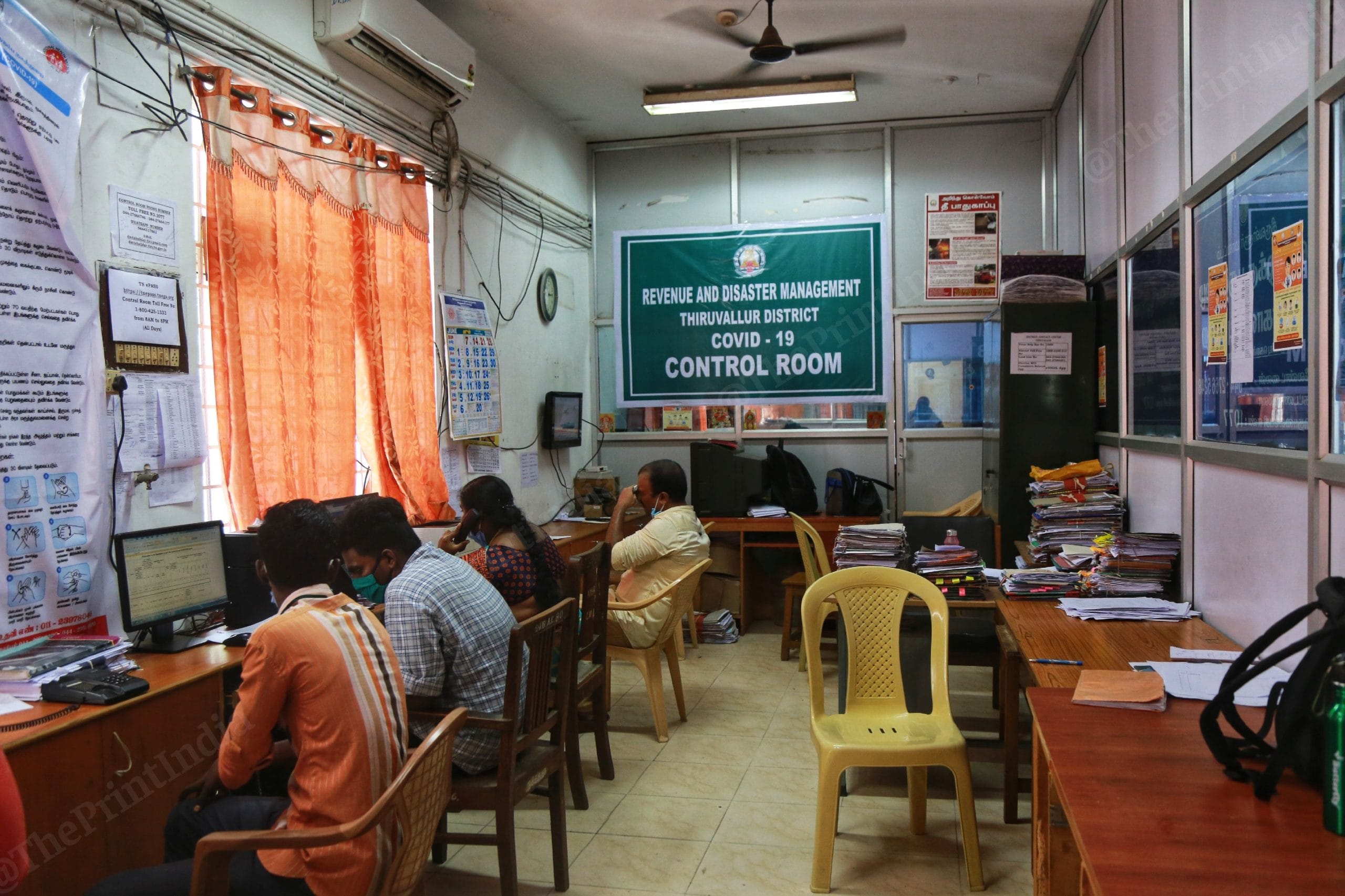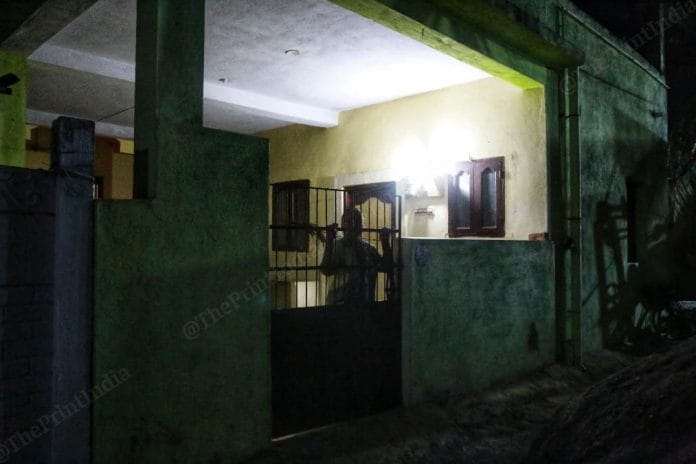Chengalpattu/Tiruvallur: Days before Unlock 1.0 came into force, the Modi government announced a list of 13 cities worst-hit by the Covid-19 crisis. Of these 13, Tamil Nadu alone accounts for three: Chennai, Chengalpattu and Tiruvallur, all to the state’s north, within a 90-minute drive from each other.
In his address to the state Wednesday morning, Chief Minister Edappadi K. Palaniswami warned about the rising number of cases in Chennai, Chengalpattu and Tiruvallur, besides Kancheepuram.
சென்னை மாநகர மக்களுக்கு அன்பான வேண்டுகோள்! pic.twitter.com/BZ3WQxgnWF
— Edappadi K Palaniswami (@CMOTamilNadu) June 3, 2020
Lying on its outskirts, Chengalpattu and Tiruvallur serve Chennai as satellite cities, with a constant movement of people among them for work and essential services. Both Chengalpattu and Tiruvallur fall in eponymous districts, which also follow Chennai in being Tamil Nadu’s worst-affected areas. As of 5 June, the two districts together accounted for over 2,800 cases.
While the case load of Chengalpattu and Tiruvallur districts is a fraction of Chennai’s, which towered at over 19,000 the same day, it begs consideration why the two cities emerged among the epicentres of India’s coronavirus struggle, way ahead of the state’s other urban centres like Coimbatore and Madurai.
ThePrint travelled to the two districts to understand why, and look at the steps being taken by authorities to mitigate infection.
Chengalpattu — Gateway to Chennai
Located approximately 50 kilometres from Chennai, Chengalpattu was a part of Kancheepuram until it was carved out as a district of its own in 2019. The district falls on the Palar river. Due to its proximity to the capital city, it is called the ‘Gateway of Chennai’. It is home to Mamallapuram, where PM Narendra Modi and Chinese Xi Jinping met each other for their second informal summit last year.
Its history dates back to the Chola dynasty. It also served as the capital for the kings of Vijayanagar after the Battle of Talikota in 1565. The city was captured by the French in 1751 and recaptured by the British in 1752. It had a strategic advantage and was used as a fortress when kingdoms wanted to advance on the erstwhile Madras.
As you walk around the city, you find shops and streets dotted with photos of the late DMK patriarch M. Karunanidhi and his son and heir M.K. Stalin — testimony to the fact that the current Chengalpattu MLA is M. Varalakshmi of the DMK.
District Collector A. John Louis told ThePrint that, according to the 2011 census, the district had a population of 21 lakh, saying it would have risen to approximately 25 lakh. Spread across nearly 3,000 square kilometres, the district had reported a total of 1,624 coronavirus cases by 2 June.
Of these, 689 had been discharged, while 920 are active cases. The toll is higher in Chengalpattu than the rest of the state. While Tamil Nadu has a reported coronavirus toll of 0.8 per cent, Chengalpattu’s stands at 1.1 per cent.
Talking about the high incidence of Covid-19 in the district, John Louis cited its proximity to Chennai. “Many people come from and go there for work,” he said.
Chengalpattu itself is an industry hub, and hosts production plants of companies such as Tech Mahindra, Wipro, Dell, Samsung and Apollo Tyres.
Louis also pointed out that many people visit Chennai to shop at the Koyambedu wholesale fruit, vegetable and flower market.
One of Asia’s largest hubs of its kind, Koyambedu reportedly draws thousands on any given day, with the festive rush nearly doubling crowds.
Since most of the over 3,000 shops deal in essentials exempt from lockdown restrictions, the market functioned through April before it was shut down amid a spurt of Covid cases in May.
Media reports from the initial phase of the lockdown suggest people thronged the market for panic purchases, throwing social distancing norms out the window.
The Tamil New Year in the second week of April brought crowds afresh. Somewhere along the way, the market was identified as a coronavirus cluster. On 8 May, 25 per cent of Tamil Nadu’s total cases were linked to the market.
Louis said the Koyambedu cluster in the heart of Chennai led to a surge of cases in Chengalpattu as well, with as many as 280 patients linked to it. He, however, underscored that the Koyambedu-linked cases have been extinguished in the district.
Chengalpattu also reported 40 Covid-19 cases connected to the Tablighi Jamaat cluster in Delhi.
Quarantine, testing, siddha
Talking about the treatment facilities in the district, Louis said it had seven quarantine facilities, and three mobile centres and two hospitals where Covid-19 tests are conducted.
According to Louis, Chengalpattu conducts anywhere between 400 and 600 Covid-19 tests a day. “In May, we conducted 12,000 coronavirus tests.”
Patients who test positive are taken to hospitals and, after three days, to a dedicated Covid care centre where doctors decide if it is OK to discharge them or continue their treatment. Some patients are also taken to Chennai. There is no exit test for asymptomatic patients.
Aside from testing, Louis said, the district conducts surveillance on households where people have influenza-like illness (ILI) or severe acute respiratory infection (SARI), along with those where members have comorbidities.
The local administration has also been providing people with herbal siddha medicine to “build their immunity”.
Out of its eight taluks, four have containment clusters: Thirukalukundram, Tambaram, Madurantakam, and Pallavaram.
The process of demarcating a containment cluster is standardised in Chengalpattu as it is across the state. Only an area with more than five index cases (the first identified infected member in a group) is labeled a containment zone. In individual cases, the houses are marked with a sticker.
In the battle against Covid-19, Louis isn’t worried about facilities and equipment, saying they are in adequate supply. His main concern is people maintaining social distance even with relaxations in the lockdown.
Meanwhile, people have concerns of their own.
Jagadha, a resident of RMI Nagar in Thirukalukundram taluk, said she didn’t know how her son had contracted Covid-19.
“He had mild symptoms such as cold and cough and tested positive. We have no idea how he got it as he never left the house since he has mental problems. I go to the local store to purchase groceries and other provisions,” she said. “Our house has been made a containment zone for the past two days. He is now in the Chengalpattu Hospital.”
Another resident of the area was sceptical about the testing protocol. “They only tested the Covid-19 patient in the house and not the rest of the members. As residents of this area, we are scared as we don’t know if they have coronavirus or not.”
Tiruvallur — the land where God sleeps
While Chengalpattu is south of Chennai, Tiruvallur is to its north. It is known as the Land of Lakes and for the Veeraragava Temple, which is among the 108 sacred shrines of Vishnu devotees.
The temple’s shrine is surrounded by a pond. It is known as the land where God sleeps, as Veeraragava is believed to have sought a place to sleep in Tiruvallur.
The district was under the Pallava dynasty in the 7th century. From then until 1947, different parts of the district changed hands between the Nawabs of Arcot, the Mughals, the Dutch and, finally, the British.
Spread across 3,423 square kilometres, the district had reported (as of 5 June) 1,191 Covid-19 cases. Out of these, 533 are active cases, while 647 patients have been discharged. Tiruvallur recorded 11 fatalities due to the virus.
Reason for surge in cases
Like with Chengalpattu, many people travel between Chennai and Tiruvallur, as the district is home to several factories and industrial estates.
Speaking to ThePrint, Tiruvallur Superintendent of Police Aravindhan P. said most local Covid-19 cases either involved someone who had travelled to Chennai, or come into contact with someone who had. Aravindham also attributed the surge in Covid-19 cases in the district to the Koyambedu cluster.
“Before the Koyambedu cluster spread, Tiruvallur had only reported 62 coronavirus cases,” he said.
Aravindhan said close to 200-300 people used to travel to Koyambedu everyday before the market was shut down in May.
He said several relaxations were announced towards the end of April — factories such as rice mills and pharma companies began functioning with the permission of the collector and were given an e-pass, while inter-district movement began 15 May onwards.
Some factories also maintained minimal staff during the lockdown to ensure all processes stay in place.
“We conducted extensive checks on the people coming to work from Chennai such as temperature checks and thermal screening. However, the rise in cases wasn’t mainly due to the relaxations in lockdown but the Koyambedu cluster and people who came from outside.”
Joint director for health in Tiruvallur, Dr D. Rani, also cited the close distance to Chennai as a reason for the rising number of Covid-19 cases. She said, “During the lockdown, the number of cases was less. However, as relaxations were allowed and people started coming to Avadi and Poonamallee (taluks) from the border, the cases rose.”
She said the Koyamebdu cluster led to the highest spike in cases in the district.
Measures taken
ThePrint contacted Collector Nageswari Reddy via phone for two days but she refused to provide information on testing in the district and mechanisms to prevent the spread of Covid.
D. Rani, however, said the district was now equipped to test samples. Until 10-15 days ago, she said, the swabs had to be taken to the King’s Lab at Guindy, which is nearly 50 km away.
Currently, tests are conducted at the Tiruvallur Government Medical College and Sri Ramachandra College, a private facility.
Police say they have an extensive plan of tracing and mapping potential Covid-19 patients. Aravindhan said the health department gave him a list of positive cases daily. The list is then shared with three teams also comprising personnel from the special branch and cyber crime.
The teams then set out for contact tracing — finding people who have come into contact with the patient in the past 14 days. If the person thus found does not exhibit any symptoms, they are home- quarantined. If they do, they are sent for institutional quarantine.
Police have also developed an app called CoBuddy for local residents who have Covid-19 or are suspected to have the disease.
The app, Aravindham said, helps police stay in touch with those who have been home-quarantined. “The link for the app is sent to those in home quarantine,” he added.
From groceries to healthcare checks, the app takes care of everything. At present, it has 500 users, said Aravindham. For families that don’t have a smartphone, police conduct manual checks once or twice a day.
Aside from the police effort, the district also has a Covid-19 control room, where a 24-hour help desk functions in three shifts. On duty are a typist, a medical officer, two health inspectors, and someone operating the help desk.

According to data provided by the local administration, as of 1 June, Tiruvallur had 15 containment clusters.
At one such cluster in Kakkalur, resident Karthik complained about a lack of avenues for garbage disposal. He pointed to a house with a Covid-19 patient, and said the garbage dump behind it was littered with medical waste such as gloves and masks, which could pose a transmission risk.
“I stay behind the house of the Covid patient. Around 35,000 people live in this area. There isn’t a proper sewage system in the area, therefore, all the waste is collected and burnt,” he said. “The garbage dump is just behind the house of the Covid patient, it has gloves, sanitiser bottles and masks. We have sent a petition to the panchayat head and the block development office in the matter.”







A very lousy report of covid status. Sorry to say !